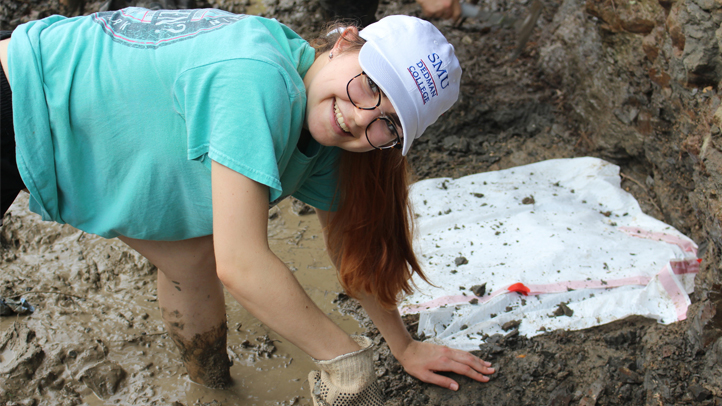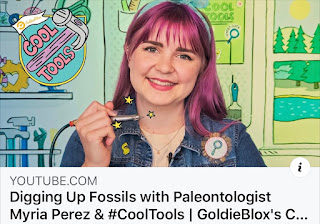From Field to Museum: How Dinosaur Fossils are Prepared
By Myria Perez, Assistant Fossil Preparator and Perot Museum of Nature and Science
When people think of a paleontologist, they usually picture a grizzled
paleontologist gently sweeping dust away from a perfectly articulated
dinosaur skeleton. In this scenario, the bones are perfectly preserved,
easily distinguishable and seem to be miraculously excavated from the
rock around it. The truth is, paleontology isn’t that easy.
In
most cases, it is rare to find fossils complete. Most fossils in the
field are fragmentary and sometimes only impressions are left behind. In
paleontology, context is everything! Field paleontologists know where
to seek out specific fossil localities for their research by examining
geological maps called topographic maps. From these maps, they can then
use a trained eye to read the rocks and identify where fossil bone could
possibly be found. When a fossil is discovered during prospecting
(hiking all day while looking for cues in the ground), notes and details
are immediately recorded about its preservation and location. Pictures
of the entire site are taken and everything is well documented before
any digging commences. Finally, the fossil is excavated with a variety
of tools depending on the nature of the rock the fossil is in. All
fossils are found in one type of rock, sedimentary, which comes in all
different shapes and sizes from sandy textured grains to more fine
grained and compact rock. The kind of sedimentary rock determines the
types of tools we use. Some popular tools of the trade include geopicks,
jackhammers, dental tools, clay knives, and shovels.
The
specimen is usually capped (plastered with burlap) with a hard shell or
“jacket” that will protect it during transportation to its final
destination, often a museum or university lab. To start this process, a
layer of highly specialized paleontological paper (toilet paper!) is
applied on the surface of the bone to create a barrier between the
plaster jacket and fossil bone. Plaster is then mixed. Layers of burlap
are then dipped in plaster and laid on the paper-covered fossil until
that side of fossil and rock is fully encased in this “jacket.” The
jacket is then flipped over and capped on the other side, totally
encasing the fossil and making it ready for transport. Field
paleontology is often conducted in remote locations that may not have
great road access. Therefore, the team of paleontologists and volunteers
may need to work together to manually haul heavy jackets across tough
terrain. In some cases, like in the Perot Museum’s In The Field
paleontology, helicopters are required to lift and transport heavy field
jackets.
Most of the fossil unveiling takes place in a prep
lab. Fossil preparators and volunteers uncover and preserve the fossils
using specific tools and techniques. Preparators slowly and carefully
break away the matrix, or surrounding rock, from a fossil. Some fossils
with softer matrix are cleaned with hand tools such as dental curettes.
Special reversible glues may be applied to strengthen weak or broken
specimens. In the end, fossil preparator’s job is to ensure that fossil
specimens are prepared and stored with care to be preserved for
researchers, artists and future generations.
Want to see a fossil
preparator working on fossils in real time? Check out the Perot Museum
Paleo Lab in the T. Boone Pickens Life Then and Now Hall on Level 4, or
better yet, join me for my paleo talk “Breaking Big Rocks into Small
Rocks,” at the second-annual Perot Museum Dino Fest celebration August 31 and September 1, where fun never goes extinct!
When people think of a paleontologist, they usually picture a grizzled
paleontologist gently sweeping dust away from a perfectly articulated
dinosaur skeleton. In this scenario, the bones are perfectly preserved,
easily distinguishable and seem to be miraculously excavated from the
rock around it. The truth is, paleontology isn’t that easy.
In
most cases, it is rare to find fossils complete. Most fossils in the
field are fragmentary and sometimes only impressions are left behind. In
paleontology, context is everything! Field paleontologists know where
to seek out specific fossil localities for their research by examining
geological maps called topographic maps. From these maps, they can then
use a trained eye to read the rocks and identify where fossil bone could
possibly be found. When a fossil is discovered during prospecting
(hiking all day while looking for cues in the ground), notes and details
are immediately recorded about its preservation and location. Pictures
of the entire site are taken and everything is well documented before
any digging commences. Finally, the fossil is excavated with a variety
of tools depending on the nature of the rock the fossil is in. All
fossils are found in one type of rock, sedimentary, which comes in all
different shapes and sizes from sandy textured grains to more fine
grained and compact rock. The kind of sedimentary rock determines the
types of tools we use. Some popular tools of the trade include geopicks,
jackhammers, dental tools, clay knives, and shovels.
The
specimen is usually capped (plastered with burlap) with a hard shell or
“jacket” that will protect it during transportation to its final
destination, often a museum or university lab. To start this process, a
layer of highly specialized paleontological paper (toilet paper!) is
applied on the surface of the bone to create a barrier between the
plaster jacket and fossil bone. Plaster is then mixed. Layers of burlap
are then dipped in plaster and laid on the paper-covered fossil until
that side of fossil and rock is fully encased in this “jacket.” The
jacket is then flipped over and capped on the other side, totally
encasing the fossil and making it ready for transport. Field
paleontology is often conducted in remote locations that may not have
great road access. Therefore, the team of paleontologists and volunteers
may need to work together to manually haul heavy jackets across tough
terrain. In some cases, like in the Perot Museum’s In The Field
paleontology, helicopters are required to lift and transport heavy field
jackets.
Most of the fossil unveiling takes place in a prep
lab. Fossil preparators and volunteers uncover and preserve the fossils
using specific tools and techniques. Preparators slowly and carefully
break away the matrix, or surrounding rock, from a fossil. Some fossils
with softer matrix are cleaned with hand tools such as dental curettes.
Special reversible glues may be applied to strengthen weak or broken
specimens. In the end, fossil preparator’s job is to ensure that fossil
specimens are prepared and stored with care to be preserved for
researchers, artists and future generations.
Want to see a fossil
preparator working on fossils in real time? Check out the Perot Museum
Paleo Lab in the T. Boone Pickens Life Then and Now Hall on Level 4, or
better yet, join me for my paleo talk “Breaking Big Rocks into Small
Rocks,” at the second-annual Perot Museum Dino Fest celebration August 31 and September 1, where fun never goes extinct!
 | |
| Myria Perez from Perot Museum of Nature and Science |



Comments
Post a Comment